
The New York Fed case study on private investments in affordable housing, "Alternative Investments in Community Development: A Case Study of Managers of Multifamily Affordable Housing Private Investment Vehicles," based on a survey of 15 managers of private investment vehicles in multifamily affordable housing, finds respondents have raised a median $300 million in equity for affordable-housing private investment vehicles since 2017.
Respondents have invested a median $169 million in affordable housing during the same period and have a median 5,619 affordable housing units in their portfolios, most of which have tenant-income restrictions.
Most properties the respondents have invested in serve households earning between 50 percent and 80 percent of area median income. Of the remaining properties in their portfolios, respondents are more likely to own and manage properties serving households earning between 80 percent and 120 percent of area median income than very-low-income households. In comparison, properties financed using Low-Income Housing Tax Credits most often serve households whose earnings are lower─60 percent of area median income or below.
The case study also found:
- Respondents with more than half of committed capital from banks invest in affordable units predominantly serving households earning 60 percent or less of area median income. Investment vehicles with mostly non-bank investors serve households with incomes above 60 percent of area median income.
- Most respondents said they anticipate raising more equity in the next 12 to 24 months than they have since 2017.
- Investment managers said they expect to increase their spending on new construction projects by more than five times in the next 12 to 24 months, saying the median investment in new construction will increase from a $27 million currently to $150 million. The median planned investment for preservation also increased, rising from the current $227 million to a projected $450 million.
- Investment managers are moving toward new strategies, which include lowering building costs through public subsidies for incorporating solar and other sustainable technologies and working with nonprofit corporations sponsored by government entities.
The case study, based on survey responses collected between April and August of 2022, was developed as part of the New York Fed's Community Development efforts, which have three areas of focus: health, household financial well-being, and climate risk.
Media Advisory: New York Fed to Release Case Study on Private Capital Investments in Affordable Rental Housing on March 6, 2023










